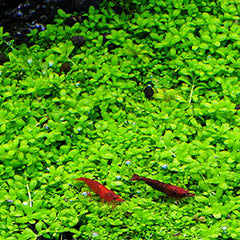Your Cart is Empty
Local Shipping within US, Canada, EU and Australia
Menu

Local Shipping within US, Canada, EU and Australia
Why choose to inject CO2 and have a 'high tech' tank?
February 05, 2025 4 min read

Opting for CO2 injection
The common definition of a high-tech aquarium is one that uses carbon dioxide (CO2) injection. This means that carbon dioxide is injected directly into the water column of the tank, making it available for uptake by aquatic plants. For historical reasons, CO2 injection equipment has been considered "high tech" and often the most expensive/complicated component of a planted tank system. The term has little to do with the actual technology used. Despite the misnomer, "high tech" serves as a good point of differentiation as CO2 injection has a huge impact and impact on a planted aquarium.
Going "high tech" generally implies an interest in growing more types and more demanding plants, and growing them in a more optimal way to produce colors and densities greater than what is possible without CO2 injection.
 The CO2 system consists of a cylinder with a gas regulator attached that injects carbon dioxide into the water of the tank. It is not as complicated as it sounds.
The CO2 system consists of a cylinder with a gas regulator attached that injects carbon dioxide into the water of the tank. It is not as complicated as it sounds.
You should consider going "high tech" if:
You want red / non-green plants



How can you tell immediately that these are images from high-tech tanks? The intensity of the coloration of the red plants and the density achieved here is an unmistakable sign of CO2 injection at work. These results are not achievable in a tank planted without CO2 injection. There are a few red species that will grow well in a low-tech planted tank setup, but using CO2 gives you many more options as well as better coloration. If growing red plants is one of your main goals, learning how to tune CO2 well is critical. A guide to growing red plants is covered here.
You want to grow carpets well


Many of the smaller carpet plants are more demanding and require CO2 injection to spread and grow well. These include species such as Hemianthus callitriodes 'cuba' (HC/dwarf baby tears), Glossostigma elatinoides, Eleocharis acicularis (dwarf hair grass).
Under good conditions, carpet plants will spread rapidly and fill most aquariums in a few months. Many of these carpet plants are small and more susceptible to algae; CO2 injection goes a long way in maintaining their health and resistance to algae. With good CO2 levels, less light is required for carpet growth, as the plant can divert energy from CO2 capture enzymes to vegetative growth instead. With more powerful lighting systems now common in planted aquariums, low/insufficient CO2 is the most common reason why some aquarists fail in their carpet growing efforts.
To find out how to grow HC, here is the plant guide.
You want 'high density' compact growth forms

Elongated internodes are common when plants are stressed by low CO2 levels; the plant channels more energy into vertical growth to break through the waterline and gain access to gaseous CO2. When CO2 levels are adequate, aquatic plants take on a denser, more aesthetically pleasing form. Leaves and stems are also more robust and less prone to algae growth.
Other impact of CO2 injection
- Allows growing of any available aquatic plants; low tech aquarium are limited to species that survive well in low CO2 levels.
- Growth speed is 5 - 10X that of non-injected tanks (if nutrient/light requirements are likewise met).
- When used in conjunction with good fertilization techniques and water parameters, it results in superior aquarium plant health and growth quality/color and a reduction in algae problems.
In summary, choose injected CO2 if you want to grow more demanding types of plants, including most carpets and colored plants. CO2 injection also allows a greater variety of plants to be grown in high density. Because of the improved plant health, algae problems are reduced/more easily managed.
CO2 injection really isn't that complicated to get started with - the equipment has become cheaper and more standardized over the years, and the science of how to manage it well has improved as well. The main drawback is the higher upfront cost of the equipment.
What are the downsides of 'going high tech'?
HIGHER COST
Additional budget for:
- CO2 system: startup cost and regular top-ups.
- Better lighting system
- Planted tank substrates
- Hardscape material (rock/ wood as desired)
- Fertilizers
The initial cost of a standard injected CO2 system (CO2 tank + regulator + diffuser) is about $250+ (in Asia, probably much less) For a 40 gallon aquarium, a 5lb cylinder will last about 3-4 months at a good injection rate. Cost of CO2 refill for a 40 gallon tank should be less than $5 USD per month.
MORE MAINTENANCE
Establishing a regular nutrient dosing schedule to meet the high growth requirements is a necessity for CO2-injected tanks. This means a budget for fertilizer and a routine for dosing.
Regular pruning due to faster plant growth. People underestimate this until it hits them in the face. Many aquatic plants WILL grow a few inches per week. We highly recommend planning ahead; using fewer stems and more slow growing species instead.
Pay more attention to water changes and cleanliness to prevent algae, especially when using high power lighting systems.
CO2 MANAGEMENT
CO2 injection itself is a delicate art. There are many aspects to ensuring that CO2 injection is well tuned. Compared to nutrient dosing, CO2 injection is more difficult to manage because there is a much wider margin of error.
The in-depth section contains the various intricacies involved; managing gaseous exchange, gauging CO2 levels, methods of injection.
unlock your true potential
Grow anything, defeat algae, create amazing aquascapes
























